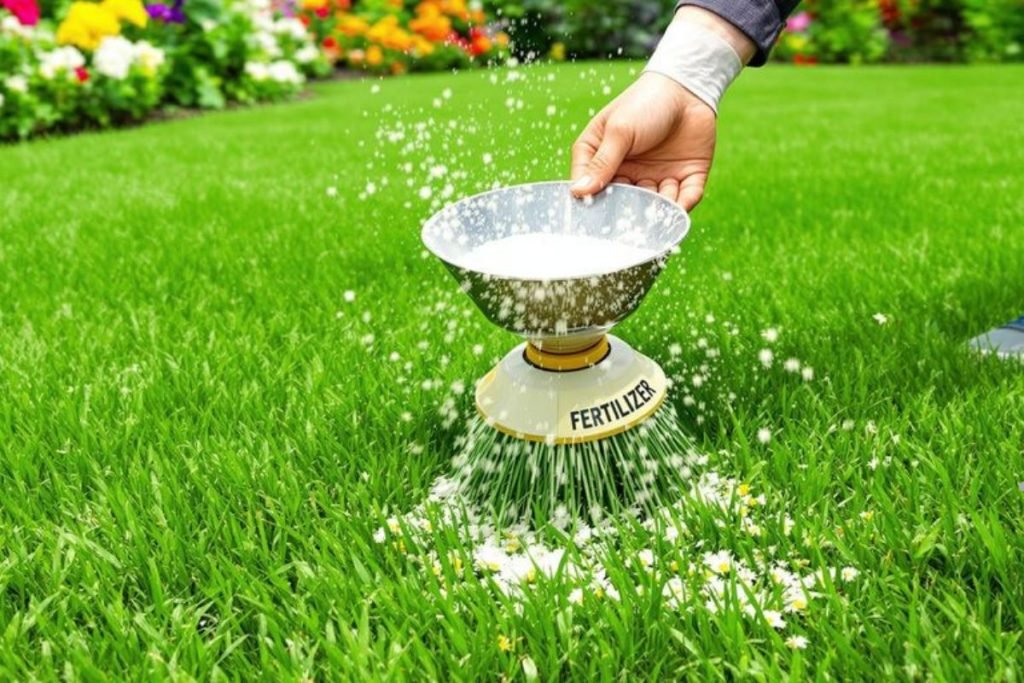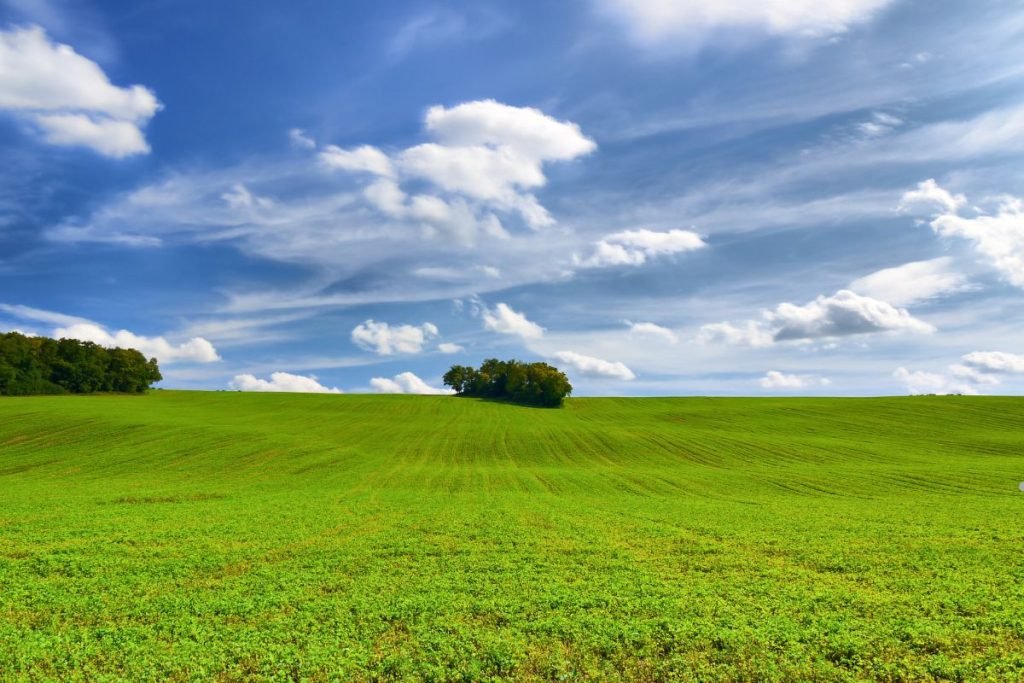
Ever look at your lawn and wonder why it doesn’t look as green or healthy as you’d like? Fertilizing might be the answer. It’s not just about appearances—fertilizing your lawn can make it stronger, more resilient, and even help the environment. Whether you’re a seasoned gardener or just starting out, understanding the benefits of fertilizing can make a big difference.
Key Takeaways
- Fertilizing helps grass grow thicker, greener, and healthier.
- It strengthens your lawn against pests, diseases, and weather changes.
- Proper fertilization supports strong root systems for lasting growth.
- Balanced fertilizing can reduce soil erosion and runoff issues.
- Choosing the right fertilizer saves money and boosts long-term results.
Understanding the Basics of Lawn Fertilization
How Fertilizers Work to Improve Soil Health
Fertilizers are like a power-up for your lawn’s soil. They replace key nutrients that get used up over time, helping to keep the ground fertile and productive. Healthy soil is the foundation for strong, vibrant grass. Fertilizers often contain nitrogen, phosphorus, and potassium—nutrients that plants need to thrive. Think of it as giving your lawn a balanced meal so it can grow better. Learn more about maintaining your lawn with Lawn Care Services.
The Role of Nutrients in Grass Growth
Grass, like any living thing, needs food to grow. The three main nutrients—nitrogen, phosphorus, and potassium—each play a unique role. Nitrogen helps the grass grow lush and green. Phosphorus supports root development, while potassium strengthens the plant, making it more resistant to stress. When your lawn gets the right mix of these nutrients, it can grow thick and healthy, creating a natural barrier to weeds and pests. It’s like giving your grass its own armor.
Call us today to ensure your lawn gets the proper nutrients for optimal growth and protection!
Common Misconceptions About Lawn Fertilizers
There’s a lot of confusion when it comes to fertilizing your lawn. One big myth is that more fertilizer is always better. Over-fertilizing can actually harm your grass, causing it to burn or grow too quickly, which makes it weaker in the long run. Another misconception is that all fertilizers are the same. Organic and synthetic options work differently and suit different needs. Finally, some people think fertilization is bad for the environment. While improper use can cause issues, balanced practices can actually help by reducing soil erosion and improving grass health. It’s all about using the right product in the right way.

Enhancing Lawn Aesthetics Through Fertilization
Achieving a Lush, Green Lawn
Who doesn’t love the look of a vibrant, green lawn? Fertilizing your grass gives it the nutrients it craves to grow thick and healthy. When your lawn has the right balance of nutrients, it can turn into that rich, green carpet you’ve always wanted. Fertilizers provide nitrogen, phosphorus, and potassium—key ingredients for that deep color and vigorous growth. If your grass looks pale or dull, it’s often a sign it needs a nutrient boost.
How Fertilizers Help Prevent Patchy Grass
Patchy spots can make your yard look neglected, even if you’re putting in the effort. Fertilization helps by promoting even growth. When you spread fertilizer properly, it ensures every part of your lawn gets what it needs. Nitrogen, in particular, is great for filling in those bare spots. Combine regular fertilization with proper watering and mowing, and over time, you’ll notice the patches fading away.
The Impact of Fertilization on Grass Texture
Ever walked barefoot on grass that felt soft and dense? That’s the magic of fertilization. By feeding your lawn, you’re encouraging the grass blades to grow thicker and more uniform. This not only feels great underfoot but also makes your yard look more polished. Plus, a denser lawn is better at crowding out weeds, which keeps your grass looking clean and healthy lawn.
A well-fed lawn doesn’t just look good—it feels good, too. It’s a win-win for you and your outdoor space.
To sum it up, fertilizing your lawn is about more than just appearances. It’s about creating a space that’s enjoyable, inviting, and easy to maintain.
Boosting Lawn Health and Resilience
Strengthening Grass Against Pests and Diseases
A well-fertilized lawn is like a strong immune system for your grass. When your lawn gets the right nutrients, it can grow thicker and healthier, making it harder for pests and diseases to take hold. Think of it as giving your grass a fighting chance. Here’s why:
- Healthy grass creates a dense surface, leaving little room for weeds or pests to thrive.
- Nutrient-rich soil helps grass recover faster if it does get damaged.
- Fertilization supports natural resistance to common lawn diseases like brown patch or dollar spot.
How Fertilization Improves Drought Tolerance
When drought hits, a fertilized lawn is better equipped to survive. Fertilizers encourage deeper root growth, which allows grass to tap into moisture buried further below the surface. Potassium, one of the key nutrients in fertilizers, also helps grass manage stress during hot and dry periods.
Here’s what happens when you fertilize:
- Roots grow deeper and stronger.
- Grass retains water more efficiently.
- Your lawn stays green longer, even during dry spells.
A little effort in feeding your lawn now can save you from the heartbreak of a brown, lifeless yard later.
The Connection Between Fertilization and Root Development
Roots are the hidden heroes of your lawn, and fertilization gives them the boost they need. Phosphorus, in particular, is crucial for root development. Without strong roots, your grass can’t absorb water or nutrients effectively. Regular fertilization ensures your lawn has the foundation it needs to thrive.
- Phosphorus strengthens root systems.
- Healthy roots improve the grass’s ability to withstand foot traffic and wear.
- A strong root system means your lawn can bounce back faster from stress.
Regular lawn fertilization strengthens the foundation of your lawn, enhancing its resilience and ability to thrive in challenging conditions.
Environmental Benefits of Proper Lawn Fertilization
Reducing Soil Erosion Through Healthy Grass
A well-fertilized lawn isn’t just about looks—it plays a big role in keeping soil where it belongs. Healthy grass, fueled by the right nutrients, grows dense and forms a protective layer over the soil. This helps prevent erosion caused by wind and water. Thick grass roots hold the soil together, reducing the risk of losing valuable topsoil during heavy rains or storms.
How Fertilizers Contribute to Carbon Sequestration
Did you know your lawn can help capture carbon from the atmosphere? It’s true. When grass gets the nutrients it needs, it grows stronger and faster, which means it absorbs more carbon dioxide during photosynthesis. Over time, this carbon is stored in the soil, making your lawn a small but meaningful player in battling climate change. Healthy soil is key to this process, and fertilization ensures the grass and soil work together efficiently.
Minimizing Runoff with Balanced Fertilization Practices
Using the right amount of fertilizer is crucial. Over-fertilizing can lead to runoff, where excess nutrients wash into rivers and lakes, causing pollution. But when done correctly, fertilization helps grass grow dense enough to absorb rainwater, reducing the chances of runoff. Here are a few tips to keep in mind:
- Test your soil before fertilizing to know exactly what it needs.
- Apply fertilizer during calm weather to avoid it being washed away by rain.
- Use slow-release fertilizers to provide steady nutrients over time.
A balanced approach to fertilization not only keeps your lawn healthy but also protects nearby waterways and the environment as a whole.
Seasonal Considerations for Lawn Fertilization
The Best Times of Year to Fertilize Your Lawn
Timing is everything when it comes to fertilizing your lawn. Applying fertilizer at the right time ensures your grass gets the nutrients it needs to thrive. For cool-season grasses, early spring and fall are ideal because these periods align with their active growth phases. On the other hand, warm-season grasses benefit most from fertilization in late spring and summer when the soil warms up and growth kicks into high gear.
Here’s a simple breakdown:
| Grass Type | Best Time to Fertilize |
| Cool-Season Grasses | Early Spring, Fall |
| Warm-Season Grasses | Late Spring, Summer |
Adjusting Fertilization Practices for Different Climates
Your local climate plays a big role in how you fertilize. If you live in a region with a long growing season, like the South, you might need to fertilize more frequently. In cooler climates, a couple of well-timed applications per year might be all you need. Rainfall is another factor to consider—too much rain can wash away nutrients, while too little might make it harder for the fertilizer to absorb into the soil.
Here are some quick tips based on climate:
- In dry regions, water your lawn right after applying fertilizer to help it soak in.
- For areas with heavy rainfall, opt for slow-release fertilizers to avoid nutrient runoff.
- In colder climates, avoid fertilizing too late in the season to prevent winter damage.
How Seasonal Changes Affect Nutrient Needs
As the seasons shift, so do your lawn’s nutrient requirements. In spring, nitrogen is key for that fresh, green growth. During the summer, potassium becomes more important to help grass withstand heat and drought. Fall is all about preparing the lawn for winter, which means focusing on phosphorus to strengthen the roots.
Here’s a seasonal nutrient guide:
| Season | Primary Nutrient Focus |
| Spring | Nitrogen |
| Summer | Potassium |
| Fall | Phosphorus |
A well-timed fertilization schedule not only keeps your lawn looking great but also helps it stay healthy and strong year-round. Paying attention to the seasons ensures you’re giving your grass exactly what it needs when it needs it.
Choosing the Right Fertilizer for Your Lawn
Understanding Organic vs. Synthetic Fertilizers
When it comes to fertilizers, you’ve got two main options: organic or synthetic. Organic fertilizers are made from natural materials like compost, manure, or bone meal. They’re great if you want to improve soil over time, but they can be a bit slower to show results. Synthetic fertilizers, on the other hand, are manufactured to deliver nutrients quickly. The big difference? Organic feeds the soil, while synthetic feeds the grass directly.
Call us today to help you choose the best fertilizer for your lawn’s needs!
Here’s a quick breakdown:
| Fertilizer Type | Benefits | Drawbacks |
| Organic | Improves soil health long-term | Slower results |
| Synthetic | Fast-acting, precise nutrients | Can harm soil if overused |
How to Read Fertilizer Labels Effectively
Those numbers on the bag? They’re not random. They tell you the percentage of nitrogen (N), phosphorus (P), and potassium (K)—the three main nutrients grass needs. For example, a 10-10-10 fertilizer contains 10% of each nutrient. Nitrogen helps with growth, phosphorus supports roots, and potassium keeps your lawn strong against stress.
Quick tips for reading labels:
- Look for the N-P-K ratio to match your lawn’s needs.
- Check for slow-release options if you want longer-lasting results.
- Pay attention to any added micronutrients, like iron or magnesium.
Matching Fertilizer Types to Grass Varieties
Different grasses have different needs. Warm-season grasses like Bermuda or Zoysia thrive with higher nitrogen levels during their growing season. Cool-season grasses like Kentucky bluegrass or fescue need a balanced mix, especially in spring and fall.
Here’s a simple guide:
- Warm-Season Grasses: High nitrogen in summer.
- Cool-Season Grasses: Balanced mix in spring/fall.
- Shaded Lawns: Look for fertilizers with extra potassium to help with limited sunlight.
Choosing the right fertilizer doesn’t have to be complicated. Start with your grass type, consider your soil health, and decide whether you want quick results or long-term benefits. With the right choice, your lawn will thank you.

Cost-Effective Strategies for Lawn Fertilization
How to Save Money on Fertilizer Without Sacrificing Quality
Fertilizing your lawn doesn’t have to break the bank. Here are a few ways you can cut costs while still keeping your grass in great shape:
- Buy in bulk: Larger bags of fertilizer often have a lower cost per pound compared to smaller packages.
- opt for slow-release fertilizers: These products may cost a bit more upfront, but they last longer, reducing how often you need to reapply.
- Use compost or homemade organic options: Kitchen scraps and yard waste can be turned into nutrient-rich compost at little to no cost.
Investing a little time into researching your options can save you a lot of money in the long run.
The Long-Term Financial Benefits of Regular Fertilization
Regular fertilization isn’t just about aesthetics—it’s an investment. A well-fertilized lawn is healthier, which means fewer expenses on Pest Control, reseeding, or even replacing dead patches. A healthy lawn is also less likely to need professional treatments, saving you from those hefty bills. For example, professional lawn fertilization services typically cost between $103 and $343 per visit. By maintaining your lawn yourself with consistent fertilization, you can avoid those recurring charges.
DIY vs. Professional Lawn Fertilization Services
Deciding between doing it yourself or hiring a professional depends on your budget and time. Here’s a quick comparison:
| Factor | DIY Fertilization | Professional Services |
| Cost | Lower (cost of fertilizer only) | Higher (includes labor and expertise) |
| Time Commitment | High (you’ll need to do the work) | Minimal (they handle it for you) |
| Expertise Required | Moderate (requires some research) | None (professionals are trained) |
If you’re short on time or unsure about the right products to use, going professional might be worth it. But if you’re willing to put in the effort, DIY fertilization can be a much more affordable route.
Wrapping It Up
So, there you have it. Fertilizing your lawn might seem like just another chore, but it really makes a difference. It helps your grass grow thicker, greener, and healthier, which means less stress about weeds and bare spots. Plus, who doesn’t love a yard that looks great? Sure, it takes a little effort, but the payoff is worth it. Give it a try, and you’ll see what I mean.
Frequently Asked Questions
Why should I fertilize my lawn?
Fertilizing your lawn helps it grow healthier and greener. It gives grass the nutrients it needs to stay strong and look its best.
How often should I fertilize my lawn?
Most lawns benefit from fertilizing about 2-4 times a year, depending on the type of grass and where you live.
What’s the difference between organic and synthetic fertilizers?
Organic fertilizers come from natural sources like compost, while synthetic ones are made with chemicals. Both can help your lawn, but they work in different ways.
Can fertilizer harm my lawn?
Using too much fertilizer or applying it the wrong way can damage your lawn. Always follow the instructions on the label to avoid problems.
When is the best time to fertilize my lawn?
The best time depends on your grass type and climate. Usually, spring and fall are great seasons to fertilize.
Is it better to fertilize my lawn myself or hire a professional?
It depends on your budget and how much time you have. Doing it yourself can save money, but professionals often have more experience.
We combine expertise with eco-friendly solutions to ensure your lawn thrives in all seasons. Whether you need regular maintenance or a complete lawn overhaul, we’re here to help. Contact now for free estimate.

